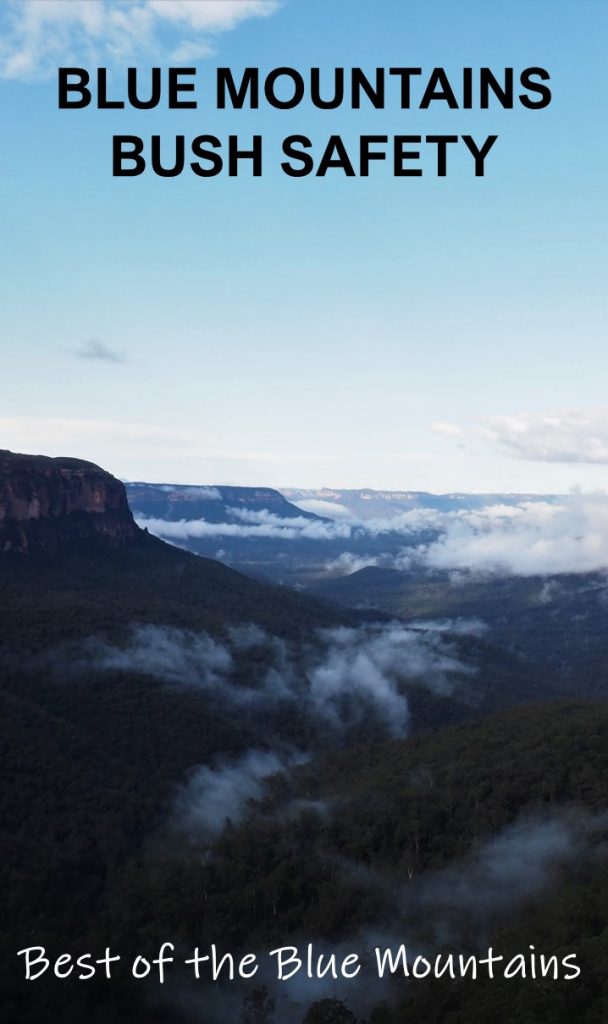Most who visit the Blue Mountains expect to do some level of interaction with nature, whether it be finding the best photography spots, birdwatching, embarking on a search for waterfalls on the Blue Mountains walks, or setting off one of the best Blue Mountains hikes for the night.
According to the NSW National Parks, around 130 bushwalkers get lost or require rescue every year. While most are found within 24 hours, others end in tragedy or an agonizing unknown for families.
Even though I’m local, there are a few bushwalking safety precautions I take whenever I venture out into the Blue Mountains bush.
This post contains affiliate links. Making a purchase through one of these links earns a small commission at no additional cost to you and is a great way to show your support to this site.

Bush Safety Tips
- Always let someone know where you are going and a rough idea when you’ll be back. If you’re staying at a hotel the reception won’t mind at all. When I go out solo I always let a friend or family member know what track I am on. Many parts of the Blue Mountains there’s a good chance you won’t have mobile phone service and if something goes wrong at least someone knows where to start looking for you. If you don’t want the expense of purchasing a Personal Locator Beacon they can be hired from some Police and Parks and Wildlife Centres. You can also download the Emergency Plus or What3Words apps to your phone to pinpoint your location in the event of needing assistance and having phone service.
- Take a guidebook or a map with you. You may not have access to Google maps!
- Stay on the marked track. There are cliffs and streams galore in the mountains and sometimes it just isn’t safe to go bush bashing. And watch where you’re going! Stop to take a photo rather than getting distracted by your phone.

Boars Head on the left and looking towards Narrowneck Peninsula
- Check for updates on the condition and status of the track. Tracks are often closed for reasons that impact their safety, such as fallen trees, landslips or flooding. Weather events in recent years, including the Black Summer bushfires and major rain events means some tracks are closed due to recovering bushland and risk of falling trees and unstable ground.
- Don’t play with the wildlife! While it may be a popular social media meme, it’s not actually that far wrong to assume mostly everything in Australia is trying to kill you. You are better off assuming that any snake you see is venomous, as many of them are, and be aware of where you put your hand on trees, you may disturb a Funnel-Web spider! Feel free to make noise as you travel through the bush, chances are snakes will feel you coming and get out of your way first. If you do see a snake stay still if you have ventured into its space (it may react out of defence but they they can’t eat you and don’t want to waste valuable venom on you) let it make its own way away from you, and move slowly away. Most snakes will only attack if they feel threatened.

- In the event of a snake or spider bite in Australia, know how to treat it. Pressure immobilisation is a technique which compresses the tissue above and below the bite to slow the spread of the venom through the body. I always carry a compression bandage in my backpack.
- Carry more water than you think you need. You may wish to consider something like a Lifestraw if you need to filter water in the bush.
- Check the local weather forecast before you set out. Not only because rain or storms could put a real dampener on your hike, but some tracks are more dangerous when wet!

Bushwalking clothes
- Long loose pants are good for potential protection from snake bite plus warmth if needed.
- Good quality shoes. I love my Merrell’s, Keen is another popular and well regarded brand for bushwalking shoes. I love my waterproof pair!
- Spray jacket. Most of these don’t take up a lot of weight or room and you’ll be thankful for it if you get stuck in the rain.
- A jumper for warmth. Even on a hot day, temperatures may drop at night if you get stuck. I always carry this great puffer jacket from Anaconda. It reduces to nothing in size and is super light, but surprisingly warm!
- Sunglasses and hat for protection, the Australian sun is stronger than you think.
What to take bushwalking
Even when I am staying local and on shorter hikes, I always have a few key things in my backpack that will be useful to me in the event of getting stuck overnight;
- A lighter
- Tissues
- Compression bandage
- Painkillers & antihistamines
- Basic first aid kit with extra shock blankets, these are good for warmth or makeshift shelter.
- Headtorch
- Trail Mix
- Something sugary
- At least 2 bottles of water
- Suncream
- Portable battery pack – it’s gonna suck if your phone battery goes flat and you need help!
Remember to have fun and don’t take unnecessary risks!
Have you got any other tips for staying safe in the Aussie bush? Let me know below and don’t forget to share!



Some great safety tips to keep in mind when hiking in the Blue Mountains!